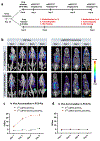Prostate-Specific Membrane Antigen Targeted StarPEG Nanocarrier for Imaging and Therapy of Prostate Cancer
- PMID: 38700450
- PMCID: PMC11281871
- DOI: 10.1002/adhm.202304618
Prostate-Specific Membrane Antigen Targeted StarPEG Nanocarrier for Imaging and Therapy of Prostate Cancer
Abstract
The tumor uptake of large non-targeted nanocarriers primarily occurs through passive extravasation, known as the enhanced permeability and retention (EPR) effect. Prior studies demonstrated improved tumor uptake and retention of 4-arm 40 kDa star polyethylene glycol (StarPEG) polymers for cancer imaging by adding prostate-specific membrane antigen (PSMA) targeting small molecule ligands. To test PSMA-targeted delivery and therapeutic efficacy, StarPEG nanodrugs with/without three copies of PSMA-targeting ligands, ACUPA, are designed and synthesized. For single-photon emission computed tomography (SPECT) imaging and therapy, each nanocarrier is labeled with 177Lu using DOTA radiometal chelator. The radiolabeled nanodrugs, [177Lu]PEG-(DOTA)1 and [177Lu]PEG-(DOTA)1(ACUPA)3, are evaluated in vitro and in vivo using PSMA+ PC3-Pip and/or PSMA- PC3-Flu cell lines, subcutaneous xenografts and disseminated metastatic models. The nanocarriers are efficiently radiolabeled with 177Lu with molar activities 10.8-15.8 MBq/nmol. Besides excellent in vitro PSMA binding affinity (kD = 51.7 nM), the targeted nanocarrier, [177Lu]PEG-(DOTA)1(ACUPA)3, demonstrated excellent in vivo SPECT imaging contrast with 21.3% ID/g PC3-Pip tumors uptake at 192 h. Single doses of 18.5 MBq [177Lu]PEG-(DOTA)1(ACUPA)3 showed complete resolution of the PC3-Pip xenografts observed up to 138 days. Along with PSMA-targeted excellent imaging contrast, these results demonstrated high treatment efficacy of [177Lu]PEG-(DOTA)1(ACUPA)3 for prostate cancer, with potential for clinical translation.
Keywords: enhanced permeability and retention; polymer nanocarriers; prostate cancer; prostate‐specific membrane antigen (PSMA); radioligand therapy; single photon excited computed tomography (SPECT) imaging.
© 2024 The Authors. Advanced Healthcare Materials published by Wiley‐VCH GmbH.
Conflict of interest statement
D. Santi and G. Ashley, are employees of Prolynx Inc. The remaining authors declare no competing financial interest.
Competing interests
The authors declare no competing interests.
Figures








Similar articles
-
Prostate-Specific Membrane Antigen Targeted Deep Tumor Penetration of Polymer Nanocarriers.ACS Appl Mater Interfaces. 2022 Nov 16;14(45):50569-50582. doi: 10.1021/acsami.2c15095. Epub 2022 Nov 1. ACS Appl Mater Interfaces. 2022. PMID: 36318757 Free PMC article.
-
Synthesis and Preliminary Biological Assessment of Carborane-Loaded Theranostic Nanoparticles to Target Prostate-Specific Membrane Antigen.ACS Appl Mater Interfaces. 2021 Nov 24;13(46):54739-54752. doi: 10.1021/acsami.1c16383. Epub 2021 Nov 9. ACS Appl Mater Interfaces. 2021. PMID: 34752058
-
In Vitro and In Vivo Study of Novel PSMA-Targeted Radioligands: Enhancing Tumor Uptake and Therapeutic Efficacy through Zwitterionization and Albumin-Binding Strategies.Mol Pharm. 2025 Jul 7;22(7):3961-3975. doi: 10.1021/acs.molpharmaceut.5c00214. Epub 2025 Jun 10. Mol Pharm. 2025. PMID: 40494649
-
Overview of selected completed prospective studies on PSMA-targeted radioligand therapy with [177Lu]Lu-PSMA-617 in metastatic castration-resistant prostate cancer.Rofo. 2025 Sep;197(9):1033-1042. doi: 10.1055/a-2514-4523. Epub 2025 Jan 22. Rofo. 2025. PMID: 39842443 Review. English.
-
Overview of selected completed prospective studies on PSMA-targeted radioligand therapy with [177Lu]Lu-PSMA-617 in metastatic castration-resistant prostate cancer.Nuklearmedizin. 2025 Aug;64(4):262-271. doi: 10.1055/a-2654-4048. Epub 2025 Aug 6. Nuklearmedizin. 2025. PMID: 40769164 Review. English.
References
-
- Wang H, He Z, Liu X, Huang Y, Hou J, Zhang W, Ding D, Small Structures 2022, 3, 2200036.
-
- Journal of Nuclear Medicine 2022, 63, 13N.
-
- Price E, Orvig C, Chemical Society Reviews 2014, 43, 260. - PubMed
- Hofmann M, Maecke H, Borner A, Weckesser E, Schoffski P, Oei M, Schumacher J, Henze M, Heppeler A, Meyer G, Knapp W, European Journal of Nuclear Medicine 2001, 28, 1751. - PubMed
- Debela D, Muzazu S, Heraro K, Ndalama M, Mesele B, Haile D, Kitui S, Manyazewal T, Sage Open Medicine 2021, 9. - PMC - PubMed
MeSH terms
Substances
Grants and funding
LinkOut - more resources
Full Text Sources
Medical
Miscellaneous

